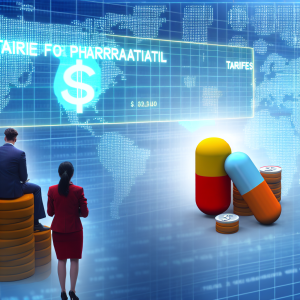President Trump’s recent threat to impose up to 200% tariffs on imported pharmaceuticals marks a potential seismic shift in the U.S. pharmaceutical landscape—one that investors and advisors cannot afford to overlook. While the tariffs are not set to take effect immediately, with a grace period of about a year to a year and a half, the implications for the drug industry, supply chains, and investment strategies are profound and multifaceted.
What’s Really at Stake?
At face value, the move aims to pressure pharmaceutical companies to bring manufacturing back to the U.S., a sector that has dramatically shrunk domestically over the past few decades. Companies like Eli Lilly, Johnson & Johnson, and AbbVie have already begun ramping up U.S. investments, but the scale and speed of reshoring required to meet such tariff threats could disrupt established global supply chains and production efficiencies.
From an investor’s perspective, this uncertainty introduces volatility and risk to pharmaceutical stocks. However, as Leerink Partners analyst David Risinger notes, the delayed implementation and the administration’s history of wavering on tariff enforcement provide some short-term relief. Pharmaceutical stocks largely remained stable following the announcement, reflecting cautious optimism.
The Hidden Costs of Tariffs
Pharmaceutical tariffs are not just a political or economic lever—they translate directly into higher costs for consumers and payers. PhRMA, the industry’s largest lobbying group, warns that tariffs would divert capital from critical R&D and manufacturing investments. Every dollar spent on tariffs is a dollar lost for innovation, potentially slowing the development of future treatments and cures.
A unique insight for Extreme Investor Network readers: A recent study by the Peterson Institute for International Economics found that tariffs on pharmaceuticals could increase drug prices by up to 15% within two years, disproportionately impacting chronic and life-saving drug affordability. This is a crucial metric for investors weighing the long-term profitability and regulatory risks of pharma companies.
What Should Investors and Advisors Do Now?
-
Reassess Portfolio Exposure: Investors heavily weighted in multinational pharmaceutical firms should evaluate their risk tolerance in light of potential tariff-driven cost pressures and supply chain disruptions. Diversifying into companies with robust domestic manufacturing footprints or those less reliant on imports could mitigate risk.
-
Monitor Government Policy Closely: The Commerce Department’s final tariff decisions expected at month-end will be a pivotal moment. Staying informed through trusted sources like CNBC, Bloomberg, and official government releases will enable timely portfolio adjustments.
-
Engage with Pharma Innovators: Companies investing aggressively in U.S. manufacturing and R&D may emerge as winners, benefiting from potential government incentives and a reshored supply chain. Look for firms with clear, transparent capital allocation toward domestic production—these could offer a competitive edge.
-
Consider Biotech and Specialty Pharma: Smaller biotech firms and specialty pharmaceutical companies often have less exposure to import tariffs and may see increased interest as investors seek growth outside traditional pharma giants.
What’s Next?
The Trump administration’s use of Section 232 investigations to justify tariffs on national security grounds signals a broader trend of leveraging trade policy to reshape critical industries. Beyond pharmaceuticals, semiconductors and other strategic sectors are under scrutiny, suggesting a longer-term pivot toward economic nationalism.
For investors, this means the era of globalization-driven pharma growth is facing a reckoning. The winners will be those companies and portfolios that adapt quickly—balancing innovation, cost control, and supply chain resilience.
Final Thought
Tariffs are a blunt instrument with complex ripple effects. While the goal of revitalizing American manufacturing is laudable, imposing steep tariffs risks unintended consequences—higher drug prices, disrupted innovation pipelines, and market volatility. Savvy investors and advisors must navigate these waters with a nuanced strategy, informed by data, policy insights, and a keen eye on the evolving geopolitical landscape.
Stay ahead of the curve by watching for updates on the Commerce Department’s studies and the administration’s final policy decisions. The pharmaceutical sector is at a crossroads, and those who act decisively now will be best positioned to capitalize on the transformation ahead.
Sources:
- Leerink Partners analyst commentary
- PhRMA official statements
- Peterson Institute for International Economics study on pharmaceutical tariffs
- CNBC and Bloomberg reports on U.S. trade policy
By integrating these insights and actionable steps, Extreme Investor Network continues to provide the sharpest, most forward-looking financial analysis for investors navigating today’s complex markets.
Source: Trump threatens pharmaceutical tariffs of 200%

